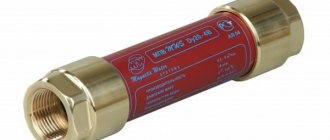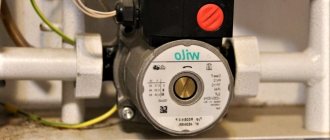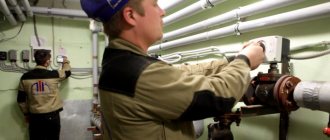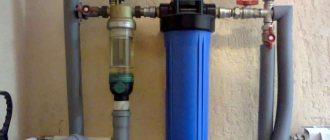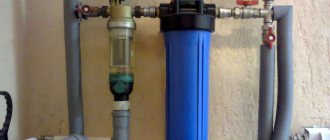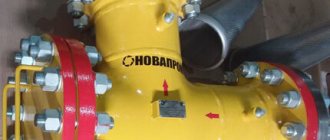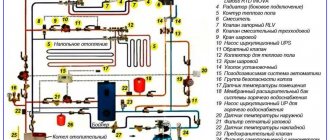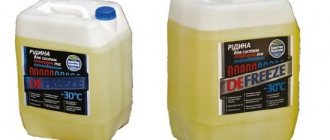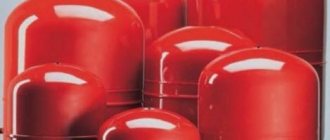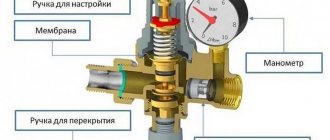What are the benefits of installing mud traps for a heating system?
There are no questions about the need to install dirt filters for water in centralized heating systems.
Where the coolant is periodically drained and the system is refilled, it is impossible to argue with the necessity of this element in the system - there will always be dirt and foreign impurities. A disdainful attitude towards mud collectors begins with the independent design of small autonomous systems. For example, heating systems of a private house. It just seems that in a small closed circuit there is nowhere for foreign impurities in the coolant to come from.
Dirt filter with tap.
Whatever type of coolant is used, and no matter what initial cleaning it undergoes, it will still be based on water. Water, which begins to interact with the metal components of the system, and there is metal in any system. As a result of this interaction, rust particles are formed that circulate in the system. In certain areas of the system (irregularities inside the pipes, welding sagging, sharp turns, narrowed passages, etc.) these particles accumulate, impeding the movement of the coolant.
Mechanical coarse water filter.
Since the intensity of circulation of the coolant decreases, in order to achieve the desired temperature parameters in the room, its temperature must be increased. This increases the load on the boiler and all other elements of the system, which does not add reliability, economy and efficiency to them. Proper installation of mud filters in the system eliminates most of these problems or, at a minimum, delays the time of their occurrence.
Functions of mud collectors
When operating heating, water supply and other similar lines, one of the most pressing problems is the clogging of various areas with insoluble impurities of organic and inorganic origin - in other words, dirt. In open systems in which water is drawn from an external source, sand, clay particles, silt, etc. most often act as pollutants. In closed pollution systems, rust flakes, scale, separated scale fragments, and mineral deposits also occur. They all have one common property: most of these particles are heavier than the water or coolant circulating in the system.
A section of a pipe with pronounced silting. Accumulating in those places where the fluid flow slows down or changes direction, dirt over time significantly reduces the performance of the system - permeability, heat transfer, etc.; in some cases, serious blockages can lead to system failure. There is a need for mechanical or chemical cleaning (rinsing) of clogged elements. In order to reduce the concentration of dirt particles in the liquid, reduce the rate of blockage formation, and thereby reduce the frequency of complex and expensive cleaning or repair procedures, various filters are used. In particular - the so-called coarse filters, which include mud filters. Sometimes they are called mud collectors, as well as clarifiers: with an effectively functioning mud collector, at the outlet of it, the pumped liquid is even visually much cleaner and lighter than at the inlet.
Peculiarities
A mud filter is a device for filtering and purifying water inside heating systems. Such a filter prevents the formation of deposits on the internal walls; it filters out foreign objects in the pipeline. This device has a number of modifications, each of which has its own characteristic differences. They comply with GOST standards; they are selected taking into account the cross-sectional diameter of the pipes. In general, the purpose of the devices is to clean the coolant before it enters the system itself.
The devices operate on the principle of a colander: water flows through a pipe into the mud pan, at the bottom of which suspensions settle. The purified liquid continues to move through the outlet pipe and enters the heating system. By changing the direction of water flow in the water supply, the mud filter divides the water into clean liquid and dirt, which settles in a special filter container.
This device is functional, you can use it to do the following:
- increase the efficiency of the heating system;
- equalize the thermal output of batteries;
- extend the service life of each element of the heating system;
- reduce home heating costs;
- reduce the risk of emergency situations and leaks;
- Eliminate the need for manual flushing of the system.
Such products protect the main components of the system from dirt and clogging of working channels. They remove dirt from contaminating pipe channels, taps, air valves, and expansion tank pipes. This ensures an increase in high-quality heating of the coolant several times. During normal operation, the water condition will be acceptable for circulation in the system without deposition of lime and alkaline salts. The heat supply inside the pipes will be correct, without wasting energy.
The mud trap is a tool for improving the operation of the system, a unit for expanding the pipeline system by changing the direction of the water flow. Typically, pressure gauges are installed near it, indicating the degree of hydraulic resistance. They are installed on both sides of the filter. A distinctive feature of the installation is the fact that the sump must be directed towards the coolant flow. For ease of installation, manufacturers make an arrow on the body indicating the direction of movement.
Over time, large debris and dirt will accumulate in the sump and will need to be removed. To service the mud pan, first shut off the system, then unscrew the nut located at the bottom of the body. After this, take out a special glass with suspensions. The container is emptied, then put in place and the nut is screwed on. The location of the sump determines the frequency of its cleaning. For example, if a buyer buys a product with a vertical glass, it will have to be cleaned more often.
The principle of operation of the mud collector is extremely simple. This process is cyclical and is repeated many times. However, choosing a product is impossible without at least a superficial understanding of the features of its varieties. After all, not every type of device is suitable in a particular case. And it’s not even a matter of price, but of the different cleaning capabilities of individual modifications.
Dirt filters for a heating system in a private home
Each heating system contains many elements and components that perform a specific purpose. For the efficient operation of the circuit and the serviceability of the devices, the cleanliness of the coolant is very important. To clean it, various filters and mud collectors are installed for heating systems. There are several types of filters, each of which performs specific functions. An equally important heating equipment is the expansion tank. It is necessary to choose its volume correctly, because the safe operation of the system depends on it.
Purpose, pros and cons of a mud filter
The mud filter for water is designed to clean and filter the coolant. If untreated water is used as a heat carrier, then it contains various impurities and salts that contribute to corrosion of the metal elements of the heating network. Salts also settle in the form of plaque on the internal walls of pipelines, causing a decrease in the lumen of the pipes and preventing the normal circulation of the coolant.
To clean the coolant from various debris and particles, mud collectors are installed in which small impurities settle and are then removed without dismantling or depressurizing the system.
The main advantages of using mud collectors:
- Filters protect circuits from becoming overgrown with dirt and deposits. This increases the service life of pipelines, heating devices and heating equipment.
- Due to the purification of the coolant, there is no need to change it frequently and use various expensive additives.
- If the circuit through which hard water circulates has many turns, then installing several filters completely solves the problem of pipeline clogging.
- An additional benefit is the preservation of the efficiency of the heating system due to the absence of deposits and debris. The efficiency of a “clean” system reaches 40%. This includes saving on electricity, because it is easier for the pump to pump coolant, and reducing fuel costs for the boiler.
- Ease of cleaning the circuit and reducing the likelihood of leaks due to corrosion are also important advantages of installing filters. The entire structure and devices will last much longer, and network maintenance costs will be reduced.
The only downside to using mud traps is the additional cost of purchasing them, but these minor costs are more than offset by the numerous benefits. To choose a suitable filter, you need to understand their types.
Installation and maintenance of main filters
Installing a carbon filter for hot water or any other type of treatment plant is quite simple
It is only important to follow the step-by-step instructions and be consistent
How to install a filter: step-by-step instructions
The installation process of the main filter consists of the following steps:
- First, you need to stop the water supply to the house, and also drain the remaining liquid from the taps in the kitchen or bathroom. This will get rid of any remaining liquid. However, before performing installation work, you need to install a basin under the insertion point for water that may leak.
- You need to put marks on the wall to fix the filtration system. The fastening must be rigid, since any vibrations can damage the system.
- Using the marks, holes are made into which the plastic pieces of dowels will be placed.
- Next, the filter is connected to the pipes using couplings. To ensure the tightness of the joints, FUM tape is used.
- The device is fixed to the wall using self-tapping screws.
- To assess the quality of installation, you need to restore the water supply and open any tap for a few minutes. During this period of time, the cartridge will be cleaned and the system will be cleared of air.
- From the moment the installation work is completed and the filters are started for the first time, the system’s service life begins to count.
How to change cartridges
Metal water filters are equipped with special removable cartridges. During operation, they may fail and need to be replaced. It is not difficult to carry out such a procedure with your own hands. To do this, you should follow these instructions:
- We turn off the tap at the entrance to the house.
- Relieve the pressure in the system.
- To prevent neighbors from flooding, it is better to place a basin under the flask.
- Using the key from the basic package, you need to unscrew the flask.
- Next, remove the filter part, wash the mesh and attach a new cartridge. The flask is also cleaned of impurities.
- After installing the flask in its original place, you need to make sure that there are no leaks.
Proper and timely replacement of working parts will ensure complete cleanliness of the liquid and eliminate the problem of pressure surges when cartridges become clogged.
How to replace the filler
And although the filling filter with filler has a simple structure, replacing this substance can be difficult. To avoid mistakes, you should follow these instructions:
- First you need to disassemble the filtration column and remove the control valve.
- Next, you should unload the used media and clean the equipment and add new filter media.
- At the next stage, the system is assembled and connected to the water supply.
What will happen to the equipment if its existence is forgotten?
It will remind you of itself when the taste of the liquid changes or the supplied stream decreases to a minimum size. After unscrewing the flask and removing the block, you will see terrible brown mud deposits and smell a putrid smell. You can buy new elements and replace them according to the scheme we described above. But try to do the treatment yourself using improvised means (citric or formic acid, vinegar or ammonia) at home.
Installation of a sump for a heating system
In order to install a magnetic filter for heating or a filter of any other type, you should familiarize yourself with the following recommendations that can simplify the entire work process:
- Even before installation begins, it is necessary to carefully prepare the system pipes, cleaning them from rust and other harmful particles.
- When deciding which type of sump design to use for a particular heating circuit, you need to be guided solely by its operational characteristics, in particular, the conditions under which the equipment will be used - operating pressure, temperature readings, etc.
- It is better to choose a location for installing the sump tank where access to the device will be as convenient as possible, taking into account that the filter should be mounted in the area in front of the circulation pump.
- One of the prerequisites for installation is that the cross-section of the filter opening must be identical to the cross-section of the pipe. This measure will ensure the strength of the connection and will prevent the mechanism from subsequently moving aside.
Principle of operation
The work of a water sump pump is based on slowing down the flow rate.
- The liquid, entering the housing, begins to move more slowly due to an increase in the flow area. Impurities are filtered out and fall to the bottom under gravity.
- Water passes through a filter element located on the outlet pipe and enters the water supply system.
- Sludge is removed through the drain pipe at the bottom of the housing. When cleaning, also check the filter mesh for kinks, tears and damage.
For normal operation of the equipment, one condition must be met - a gradual increase in hydraulic resistance, which can be monitored by the indicators of instruments located before and after the mud trap.
Magnetic filters
To clean the hydraulic transport of heating systems, magnetic mud collectors, which appeared relatively recently, are also used. A magnet located inside the dirt trap pulls metallic inclusions out of the liquid and accumulates them in the reservoir. In this case, the device does not change the pressure in the pipes and does not slow down the water flow. Prevents the possibility of scale formation on the walls of pipeline fittings. Therefore, it can be installed on the suction sections of the pump.
The liquid here undergoes two-stage purification: coarse and fine. At the first stage, impurities larger than 500 microns are removed. The second contains smaller particles. During operation, a magnetic field is created, which helps soften the water and reduce the amount of salts.
Cleaning the cartridge filter
Such systems, often installed in country houses, are cleaned in a different way. You will need a filter key, a pan or bucket, a replacement cartridge or a container where you can clean the old one.
First, turn off the valve and make sure that there is no water left in the tap. Then place a bucket underneath: excess liquid from the flask will be drained there. Using a special wrench, you need to unscrew the nut and remove the flask. After this, you can either install a new cartridge, or thoroughly rinse and return the old one to its original place. Then the flask is returned to its place, the nut is screwed back in, and the water is turned on.
Not any cartridge can be reused: this option is only for wound ones. You can wash such a product using strong water pressure (it is recommended to use a hose for this).
If there is no possibility of replacement
It happens that the equipment is mounted in such a way that it is impossible to disconnect and remove it. For example, the flask is pressed against an installed bathtub, located behind a kitchen unit with a cast corner countertop that cannot be removed, or mounted without clearance for removal. In this case:
- if a non-working filter is located on a branch, it can be plugged and a new one installed by cutting into a new section of the pipe;
- if it is impossible to plug it, you need to arrange for a new pipe to be inserted above the old system and install new equipment to bypass the old connection;
- install a local system under the sink - a multi-stage or reverse osmosis filter.
How does a mechanical cleaning filter work?
Mechanical cleaning filter device
To understand how to install the filter correctly, let’s take a closer look at what parts it consists of. A detailed diagram of the heating system sump device can be seen in the figure. The body is usually made of brass. Large diameter industrial models may use cast iron. The working part is a fine-mesh steel mesh. As a rule, it can be removed for washing or replacement. The frequency of cleaning the heating system's mud traps depends on various parameters: water hardness in your region, pressure in the pipeline, and the total volume of coolant passing through the filter. There is also a dependence on the materials from which the pipes and components are made. Materials with different corrosion resistance will pollute the coolant at different rates. You can set the required frequency experimentally. The figure shows methods for installing a filter in a pipe with explanations for each of the possible options. As we can see, both with vertical and horizontal insertion, the glass for depositing filtered particles should be at the bottom.
Methods for installing a filter in the system
In conclusion, it should be added that it is often advisable to use a combination of filters to increase the service life of the system. For example, a mud trap for heating and a magnetic filter for a boiler. Or a system of mesh cleaners installed in series.
How to choose
When choosing a cleaning device, you should proceed from the purpose of each specific device. The coarse filter for individual use has smaller volumes and is easier to install and clean. Devices for apartment buildings and industrial purposes are chosen by specialists.
When purchasing, you should check the device for visible damage and cracks - exclude manufacturing and shipping defects.
Design flaws are a relative concept. He who is forewarned is forearmed. Therefore, in each specific case, before purchasing, you should read the instructions for using the model and inquire with the seller.
Inconveniences, unfortunately, are revealed only during operation, but this does not affect the quality of the filter; it only complicates maintenance and operation.
Before purchasing, you must make sure that the model's configuration fully complies with the stated list in the instruction manual. A warranty is required. When installing the filter yourself, you cannot use incomplete parts and tools if special fittings and keys are included in the purchase.
What are filters for heating systems - types
The following types of heating filters are distinguished:
- Rough or pre-cleaning. They must be installed at the stage of connecting to the central water supply (if such a possibility exists). The most reliable model is a sedimentation tank with a flask for the accumulation of pollutants.
- Fine cleaning. Detains contaminants up to 100 microns in size.
- Magnetic devices. They attract metallized components - chips, rust, etc.
Let's take a closer look at each type.
Coarse filters are designed to retain large contaminants and can be installed simultaneously in several areas of the system. Presented in the following modifications:
Mud collector: connects to the central heating system, at branch points (can be flanged, welded, threaded), Sump filter: a more modern model, dirt is retained in a special flask made of heat-resistant plastic (due to the transparency of the flask, you can control its filling level). Fine cleaning – installed as an addition to coarse cleaning devices. The main impact in such devices is taken by the square or cylindrical cassettes installed inside
Such devices can be attached to the wall, which is especially important for plastic pipes. Magnetic filters - consist of two magnets with opposite poles. Metal waste entering a magnetic field is attracted and retained by such a device
The design can also be equipped with a dirt filter. Magnetic models can be either removable and quite easily installed on the pipe, or non-removable. Recommended as an additional cleaning device.
Many people ask the question: is it worth spending money on purchasing all types of filters? Perhaps only a coarse cleaning device will be enough? Experts assure that the most effective protection will be provided by all types of structures that will retain as much possible contamination and impurities as possible. The coarse filter can only cope with large particles, and this is not enough for the heating system to fully operate for a long time.
Types of mud flies
The most common type of mud filter is a mesh filter. Such a filter is used to collect mechanical impurities, as well as to filter the environment. A filter mesh is installed in the body of the cleaning device. With its help, cleaning is carried out.
Mesh filters, in turn, are divided by function:
- Depending on the type of flushing, they are: self-flushing, flushing and non-flushing.
- According to the degree of removal of foreign substances: fine and coarse cleaning. Fine cleaning has a mesh thickness of up to 5 microns, and coarse cleaning - up to 300 microns.
- Depending on the type of connection to pipes, they can be flanged or threaded.
The mesh mud filter can be classified as a coarse filter. Such devices are used to purify liquid in pipes of heating systems and water supply. They purify liquid from suspended large and medium-sized fractions.
How often does it need to be cleaned?
Due to water purification and retention of various debris, which does not disappear over time, it begins to accumulate. For this reason, over time, the water filter installed on the pipe becomes clogged. This leads to a decrease in water pressure, and over time, its complete absence. When such situations occur, it is necessary to clean the internal structural elements, for which the device should be removed, disassembled and washed.
Worth knowing! When the filter is sealed along with the water meter, you need to call a technician from the management company who will remove the seals. Once cleaning is complete, it is recommended to install a non-return valve, allowing cleaning to be carried out without the need to call a specialist further.
Purpose of coarse water filters
Coarse filters are designed to retain large particles (hard and soft), thereby providing primary water purification. When used in individual water supply systems, such devices mainly retain silt, sand, and clay coming from wells or wells. With a centralized water supply, such contaminants do not enter the water, but when water is transported through outdated pipes, rust particles end up in it. At the same time, the chemical composition of the water remains unchanged.
Coarse filters are also installed before installing meters, washing machines and dishwashers, which reduces the risk of breakdowns due to low water quality and thereby extends the life of the equipment.
Thus, among the main functions of coarse filters are the following:
- eliminating pollutants that could make water consumption hazardous to health;
- protection of the plumbing system (pipes, gaskets, connections and bends) from abrasive wear;
- preventing pipe clogging;
- protection of household appliances and water meters from damage and wear caused by exposure to polluting particles;
- elimination of foreign tastes and odors of water caused by the ingress of foreign particles into it.
Such devices may have different designs, dimensions, and degrees of water purification, but they all work on the same principle - they create a barrier to the passage of polluting particles and allow water to pass through.
Why is it worth installing a filter on your heating system?
Many users may quite logically be interested in the question of whether it is necessary to install filters for heating systems? It is worth noting that even without organizing cleaning, the equipment can function normally, another question is how long?
First of all, such an installation is necessary to ensure reliable and uninterrupted operation of heating equipment, eliminating emergency situations and failures.
The price of heating filters is not so high; its timely purchase and installation will cost much less than later repair or replacement of heating elements. Not to mention the fact that an accident in the heating system will lead to such unpleasant consequences as cold and discomfort in the house (after all, it is during the cold season that the thermal regime must be maintained).
The advantages of the installation include:
- reliable protection of the system from blockages;
- it is not necessary to change the water (coolant) so often;
- the service life of heating equipment is extended;
- cost savings;
- confidence in the reliability and uninterrupted operation of the system.
Reticulate
The mesh device is a housing with a mesh filter inside. The most popular option looks like a piece of pipe with a diagonal “spout” (bend), at the end of which there is a screw-off plug. Water, passing through the mesh, leaves suspended matter in it and then goes into the purified system.
From time to time you have to unscrew the plug and remove the filter mesh for washing. Then everything is put back in place, and the device itself does not need to be removed from the pipe. This is the so-called flushing threaded mud sump, but there are many more different types.
According to the type of self-cleaning, the mesh filter can be:
- non-flush - rinsing is carried out after removing the device and disassembling it;
- flushing - to clean, just unscrew the plug and remove the mesh;
- self-flushing - dirt is removed from the mesh by a water flow from the opening of a special drain valve.
Depending on the mounting method, coarse filters differ in:
- welded;
- threaded;
- flanged.
Most heating models have an additional mesh to separate air from the water flow. When it accumulates excessively at the top of the mud trap, the float is activated, and the needle valve allows the gas to exit the device.
The effectiveness of the mesh option directly depends on the smoothness of the increase in hydraulic resistance in the system, both before and after it. Constant changes in pressure in the pipes can cause dirt particles to be forced through the mesh.
You can track the degree of contamination of the mesh by constantly removing it and visually checking it. Or install pressure gauges on both sides of the sump tank and use their readings to monitor how dirty the filter is. There are also variations with a glass bulb for visual inspection.
How to clean the coarse filter
The frequency of replacing or cleaning the filter device largely depends on the quality of the water.
Cleaning the coarse water filter is not that difficult. The owner of the apartment or an invited specialist can clean the filter in front of the meter. In a new water supply such measures can be carried out rarely, in old houses - more often.
But the device must be washed at least once a year, regardless of the condition of the water pipes. It is undesirable to wait until the pressure in the water supply system decreases. Over time, it will be more difficult to unscrew the thread. The valve located in front of the filter apparatus must be handled carefully. Its breakdown can lead to unpleasant consequences.
The filter is cleaned in the required order:
- First, the movement of water through the pipes is necessarily blocked.
- Then the cover installed on the slope is smoothly removed.
- The mesh needs to be removed and cleaned using a brush with hard bristles. Rinse the coarse filter, being careful not to damage the mesh.
- If the mesh is damaged, it may need to be replaced.
- The device tank also requires cleaning.
- Then the mesh returns to its place.
- At the last stage, the cover is returned back and the seal is installed on the connection.
Before using water, check the system for leaks. Often the filter element is sealed, so you cannot clean it yourself and it is recommended to invite a specialist, because After cleaning the device, the seal will need to be restored.
How to clean a cartridge (cartridge) filter
To clean such a device you will need the following kit:
- containers for washing the cartridge and draining waste;
- replaceable cassette (if necessary);
- special key.
Procedure for cartridge filter:
- the water supply to the apartment is cut off;
- using a wrench, unscrew the clamp nut and remove the filter flask (after placing a container to drain water from the system);
- The cartridge removed from the device is washed, and the cartridge is replaced if necessary;
- the device is assembled in the reverse order and tightened with a key;
- The water supply is restored and the operation of the system is checked.
Main types of filters and their design
Today, several designs of mud filters for heating systems have been developed. The principle of operation is similar for all - filtration of a coolant liquid, extraction of solid insoluble inclusions and their accumulation in a filter element or settling tank. Depending on the type of system, there are mud filters for industrial systems, and there are those that are used in individual heating installations, for example, in apartments or private houses.
Classification according to installation and cleaning method
Mud traps for heating systems are most often classified according to the method of installation in the system:
- On a threaded connection;
- Installed using flanges;
- Devices that require welding for installation;
New devices for plastic heating pipes are installed by soldering, so they can conditionally be classified as welded, although today they can be called a separate type of classification.
Classification according to the degree of purification divides filters into coarse filters and fine filters. The former are capable of capturing only large particles, but fine filters are capable of sifting out particles of several microns.
Classification by method of service
There is also a classification according to the method of maintenance, in other words, because the contents of the filter elements are cleaned:
- Self-cleaning;
- Flushing;
- Non-flush;
The former are cleaned by washing the mesh when opening the valve on the filter housing. All contents are simply discharged out through the valve. In washable filters, after removing the lid or flask, the filter element is removed and cleaned first with a brush and then washed with a stream of water. Non-flush ones require complete removal from the system and maintenance in workshops or replacement with a new mud collector.
For a specific heating system, it is also important how the coolant is cleaned. The simplest and most common are mesh filters.
In the body of the mud tank, the coolant passes through a stainless steel mesh and insoluble particles are retained on the metal. To clean the filter itself, rinsing is done by opening the valve on the body or removing the mesh from the filter bowl
The simplest and most common are mesh filters. In the body of the mud tank, the coolant passes through a stainless steel mesh and insoluble particles are retained on the metal. To clean the filter itself, washing is done by opening the valve on the body or removing the mesh from the filter bowl.
Strain filters are installed both in small installations and in industrial heating plants. The advantage of this type of device is its reliability and simplicity of design.
In addition to the usual mesh filter, mesh filters with self-cleaning and with the additional function of an air vent have recently begun to be used. In addition to the coarse filter, a separator filter made of a fine mesh network is installed in the housing, which ensures the separation of gas particles and removes them to the air vent. The operating efficiency of this type of device largely depends on the pressure in the line - the higher the pressure, the more effective the process of cleaning and degassing the coolant.
Magnetic filters are similar in design to mesh filters, the only difference being that magnets are installed around the mesh in the housing, which attract metal particles and rust.
Another type of device provides cleaning of the coolant using gravity. The filter housing is a large-diameter container in which pipes for inlet and outlet of coolant are installed at different heights. When entering a large-diameter settling filter, the liquid changes direction of movement, which results in the formation of numerous flows and turbulences. Heavy particles break off and settle to the bottom of the filter. Such installations are most often used in industrial boiler houses and heating plants.
Operating principle and design
Mud collectors may differ to a certain extent in design, but in their work they use three basic principles:
- inertial-gravitational;
- mechanical;
- magnetic.
These principles can be used individually or together.
1. Inertial-gravitational principle. A typical mud trap is a vertical or horizontal metal cylinder with a diameter significantly larger than the diameter of the pipes in the section of the system in which it is installed. The liquid, entering such a cylinder, instantly loses speed, due to which the heavy particles attracted by it are able to sink to the bottom under the influence of gravity. Some mud tanks also use the inertia of these particles: additional partitions are installed in the mud tank cylinder, directing the liquid along the walls of the cylinder; centrifugal force forces particles toward the walls, after which they themselves sink to the bottom.
Scheme of a vertical gravitational mud trap. To simplify the procedure for cleaning the mud tank, the bottom of the cylinder is made removable, or a separate tap is provided for draining the liquid mud suspension.
2. Mechanical principle. However, gravity and inertia are not able to separate lighter, suspended particles from the liquid. For this purpose, there are mesh filters that mechanically retain all particles with sizes exceeding the size of the mesh cells.
The disadvantage of mesh filters is that if the level of contamination of the filtered liquid is high, they themselves become clogged quite quickly. Therefore, it is logical and expedient to use a mesh filter as a “second-stage” filter - that is, install it in such a way that heavy particles are filtered out first, and then suspended ones.
Vertical and horizontal mud traps with a “cup” of a strainer in front of the outlet pipe. To clean the strainer in the mud pan, it is usually possible to remove it for washing, or to wash it locally using reverse liquid pressure. https://escortcity.co.nz.
3. Magnetic principle. If the working fluid is expected to contain particles with magnetic properties - small metal shavings, scale, etc. – you can add a permanent magnet to the design of the mud pan, which will collect metal debris on its surface. Naturally, it must be possible to clean this magnet - for example, according to the principle of a magnetic plug in the oil sump of a car engine. Actually, the engine crankcase can be conditionally considered a special case of a mud trap.
Installation of a sump for a heating system
In order to install a magnetic filter for heating or a filter of any other type, you should familiarize yourself with the following recommendations that can simplify the entire work process:
- Even before installation begins, it is necessary to carefully prepare the system pipes, cleaning them from rust and other harmful particles.
- When deciding which type of sump design to use for a particular heating circuit, you need to be guided solely by its operational characteristics, in particular, the conditions under which the equipment will be used - operating pressure, temperature readings, etc.
- It is better to choose a location for installing the sump tank where access to the device will be as convenient as possible, taking into account that the filter should be mounted in the area in front of the circulation pump.
- One of the prerequisites for installation is that the cross-section of the filter opening must be identical to the cross-section of the pipe. This measure will ensure the strength of the connection and will prevent the mechanism from subsequently moving aside.
Useful tips
To increase the service life of filters, you should follow these tips:
- evidence that the filter is clogged is a decrease in water pressure in all faucets;
- the more intense the water flow, the more often the structure should be cleaned; it is recommended to do this every 3 months;
- before unscrewing the outlet of the mud trap, you should substitute a basin or bucket, and also open the tap on one of the mixers;
- When cleaning cartridge filters, it is recommended not to wait until the walls of the flask are covered with a brown coating;
- If a stole gasket is used, the plug should be made hot before unscrewing, using a gas torch or a regular lighter.
Having figured out how to remove debris from the filter, it is worth remembering the regularity with which it is important to do this. In the process of clearing the blockage, it is important to take into account the design features of the installed model, as well as maintain the tightness of the threaded connections during reassembly
Filter element service life
The service life of the filter element is affected by:
- Product quality;
- No violations during installation work;
- Water quality;
- Frequency of cleaning.
If you purchased a defective filter element, which was then installed incorrectly, then you can’t count on any high liquid cleaning performance.
The dirtier the liquid circulating through the water pipes, the more often you will need to remove the sump and remove debris. In general, the service life is tens of years.
Additional structural elements
The design of the mud pan may also contain other elements that simplify maintenance or increase its functionality:
- in addition to the mentioned drain valve at the bottom, there is an air valve at the top of the mud pan to de-air the system when filling it with liquid;
- at relatively low pressure levels in the system, a transparent window can be provided on the side surface of the cylinder to assess the degree of contamination;
- Pressure gauges can be installed on the inlet and outlet pipes, by the difference in readings of which one can estimate the hydraulic resistance of the mud tank and, as a consequence, the same degree of contamination.
Mud traps can be produced with a flange connection and a “weld” connection. The first option is considered preferable, as it allows the mud collector to be easily replaced if necessary. However, such a replacement is rather an exceptional event: due to the simplicity of the design, mud collectors are extremely reliable, their service life is up to 30 years or more.
Violation of the tightness of system elements
Violation of the tightness of system elements (pipes, connections, twists, welding, etc.) leads to a coolant leak, which, if not eliminated in a timely manner, can cause an emergency and lead to large material costs for its elimination.
In pipelines, leakage occurs due to pipe corrosion, which causes metal destruction, the formation of through holes (fistulas) and pipe ruptures. Corrosion of pipes increases during long-term operation, especially if the system is not flushed. Corrosion also increases when the system is filled with tap water (containing a lot of oxygen), and the system is frequently emptied, which allows air oxygen to enter it.
To prevent accidents in winter, it is necessary to inform the relevant services about any damage detected during the preparation for the heating season. When repairing, require careful pressure testing of the heating system in order to timely identify sections of pipelines weakened by corrosion.
Leaks can occur where pipes are bent, through cracks caused by improper bending. Leak points are eliminated by welding defective areas and replacing faulty areas.
To quickly (but temporarily) eliminate leaks on straight sections of a pipeline with a diameter of no more than 150 mm, install sealing clamps on the damaged section of the pipeline. Use this method when it is impossible to disconnect the damaged section and empty the pipeline. As soon as it becomes possible to disconnect the damaged section of the pipeline, remove the clamp and carry out repairs.
In a threaded connection, coolant leakage through leaks, as a rule, occurs due to poor-quality seals made during installation in the joints between the couplings and locknuts, cracks in the connections, torn and deeply cut threads. After determining the causes of the leak, either reassemble the threaded connection and re-seal it, or replace it.
Eliminate small leaks (fistulas) by welding linings to the pipeline. Fill small fistulas and cracks with welding. In flange connections, leakage occurs as a result of weak tightening of the bolts, aging of the gasket, its being made of low-quality material, or misalignment in the flanges. If, when tightening the bolts, the leak in the flange connection is not eliminated, then replace the gasket.
In a welded joint, leakage can be caused by poor welding quality, which is revealed by temperature expansion. Eliminate this malfunction by additional welding of the defective joint.
Varieties
To reduce the risk of boiler breakdown, increase the accuracy of measuring instruments and ensure a long service life of the equipment, it is important to understand the main types of devices and choose the right one
Polyphosphate
Polyphosphate units are considered a budget option for pre-purification and softening of water entering the boiler.
The operating principle of such a device is to pass liquid through a flask filled with special crystals. They ensure the formation of a protective film on the inner walls of the boiler and also slow down the formation of scale.
Photo 1. Polyphosphate filter for a gas boiler, filled with special crystals. They slow down scale formation.
The devices have a simple design:
- drain;
- flask;
- filler;
- lid.
The liquid enters the flask with filler through the lid, where it is passed through polyphosphate crystals. Next, it goes through the drain into the gas boiler tank.
Any device of this type requires periodic replacement of the filler - sodium salt crystals. As a matter of fact, this is the only difficulty in servicing them. The average lifespan of such a treatment plant is up to one and a half years.
Electromagnetic or magnetic for softening hard water
Electromagnetic devices are expensive, but the price is completely justified: the installation lasts a long time and allows you to obtain perfectly clean water at the output.
The principle of operation is that when the liquid passes through the flask, the salts in it disintegrate. Thus, scale will not settle on the walls of the boiler. Instead, the filter itself will be clogged with tiny salt particles, which is periodically washed.
Photo 2. Three magnetic filters for a heating system boiler; the scale in them breaks down into tiny particles.
Another characteristic is that under the influence of electromagnetic radiation, not only does the scale disintegrate into small particles, but also a thin film is formed that covers the boiler heat exchanger. Thanks to this, it remains protected and does not corrode for a long time.
We should not forget that electromagnetic and magnetic devices are different installations. At the heart of both is a magnet.
Attention! Electromagnetic devices are more powerful because they require connection to an electrical network. Ideal for gas boilers, as they perfectly soften water of any temperature
Magnetic installations are less strong and are not recommended for use with gas boilers if the water hardness is too high.
Magnetic devices consist of a metal case, inside of which there are a large number of strong magnets. Electromagnetic devices are additionally equipped with an electric drive, the operation of which allows the effect of magnets to be greatly enhanced.
Cartridge for cleaning
Cartridge devices have low throughput. The following device types exist:
- Mechanical - traps small debris. Such devices need to be cleaned frequently, and they do not soften the water.
- Coal - purify water due to activated carbon, which acts as a filler. If you do not change it in time, the water will become even more contaminated as a result of passing through the filter.
Photo 3. Four low-flow cartridge filters are needed to purify the water.
- Ion exchange cartridge devices are considered the best, as they change the hardness of water by entering into a chemical reaction with calcium and magnesium ions.
- Osmotic - allow molecules of water and gas to pass through them. This allows you to clean the liquid from metal impurities and harmful microorganisms, but it will not be possible to soften the water by installing such a filter.
- Membrane - purify water from debris and impurities, but do not soften it.
Important! Cartridge filters are not suitable for gas boilers (with the exception of ion exchange devices). They are more focused on purifying the water you are supposed to drink.
Filtration stages in the water treatment process
The first, most important step in water treatment is mechanical purification. Coarse cleaning devices remove particles of 1 micron and above from water. They perform an irreplaceable function in the filtration process, without which further water purification is impossible.
Rust, sand, clay particles, scale from old water pipes - everything is removed to obtain clear water at the output.
- Throughout the autonomous water supply system, it is equipped with a set of filters that perform various water purification tasks
- The very first in the circuit is a mesh filter, which retains mineral and organic particles mechanically.
- A similar mesh filter, which performs rough water purification, is placed at the inlet of the surface pump: either at the edge of the suction pipe or in front of the unit pipe
- If the pump is supposed to pump water directly to the consumer, for example, to a swimming pool, then a mesh filter is installed on the pipe, and in front of the pump is a sorption filter
- To protect the equipment included in the water supply scheme, so-called mud filters are used - coarse filters. They are placed mainly inside the house, but it’s great if they are located in outdoor areas
- Water is prepared for drinking use using cartridge filters that absorb contaminants and fine purification systems.
- Filtering devices with cartridges located inside carry out iron removal, retention of heavy metal salts and softening
- Fine water purification is carried out by systems that include a series of superfine filters, as well as reverse osmosis systems that remove bacteria and harmful microorganisms.
Only after the first stage of pre-filtration can you begin to remove organic impurities, heavy metal compounds, chemical elements and microorganisms. For this purpose, ultrafine filtration devices are used.
It is possible to determine more specifically the need for cleaning from certain contaminants only on the basis of analysis results.
To choose the right filter, you need to clearly define why its installation is needed:
- for filtering hot and/or cold water;
- what kind of contaminants need to be cleaned from;
- what capacity and loading volume should the filter have;
- for what purposes - to protect plumbing and equipment or for drinking water and cooking.
It is also necessary to take into account where the device will be used - in a private house, apartment, boiler room or industrial enterprise.
When purchasing a filter, you can check the data with the table and make sure whether the declared level of purification corresponds to the capabilities of the product. For example, often the parameters of a fine cleaning device indicate the ability to filter from impurities as small as 100 microns, which in reality refers to coarse cleaning
